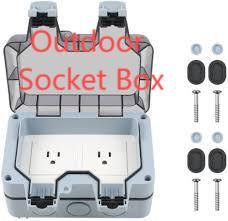Specifying the right enclosure early in a project can prevent many downstream problems, which is why professionals often place an Outdoor Socket Box at the center of external electrical layouts, and in many designs the Outdoor Socket Box functions as a primary access point for temporary power, lighting, and equipment. Thoughtful selection and correct installation reduce the risk of moisture ingress, corrosion, and accidental damage, while improving serviceability and long-term reliability for outdoor systems.
The role of enclosures in outdoor power systems
A robust enclosure protects internal connections from environmental stresses such as rain, dust, and temperature swing. It also helps maintain mechanical integrity in the face of vibration and impact. When protection is paired with clear access and sensible internal layout, technicians can perform inspections and repairs more quickly and safely.
Essential attributes and installation best practices
Evaluate sealing methods, entry points, and internal mounting features. Good sealing prevents water and particulate ingress, while properly designed cable entries and strain relief reduce conductor stress. Internal mounting brackets and removable panels simplify component replacement and future upgrades, saving both time and money over the product’s service life.
Correct placement and mounting reduce exposure to standing water and direct spray. Keep units above likely runoff lines and away from areas where debris accumulates. Follow recommended sealing and grounding procedures, and use appropriate gland selections for cable types. Tightening torque, gasket seating, and periodic inspections are simple but effective measures to prevent common failures. Standards and testing are also essential; specifying products with clear environmental validation reduces field uncertainty. Good documentation — installation drawings, parts lists, and torque recommendations — helps teams install units correctly. Training on sealing, gland selection, and simple inspection checklists helps technicians catch issues early. Planning spare parts for common wear items such as gaskets and fasteners avoids service delays, while retrofit-friendly designs can accept monitoring devices and upgrades later.
Modularity, lifecycle and sustainability
Enclosures that accept modular inserts and spare sockets allow systems to be upgraded without full replacement. This modular approach supports phased deployments and enables organizations to respond to changing requirements with minimal waste. Retrofit-friendly designs also make it easier to incorporate monitoring or protective devices in the future. Choosing an enclosure should account for total cost of ownership rather than just upfront price. Higher-quality materials and thoughtful engineering often reduce failure rates and maintenance effort. Standardizing on a family of compatible enclosures across multiple sites reduces spare part complexity and supports more efficient technician training. Durable and repairable designs contribute to reduced material waste over the lifecycle of an installation. Selecting enclosures that can be updated, repaired, or retrofitted avoids premature disposal and supports circular-economy goals.
Contractor and operator perspectives (Nante)
Contractors appreciate enclosures that shorten installation time through intuitive access and clear labeling. Operators value predictable maintenance intervals and parts that can be swapped quickly on site. When manufacturers provide robust documentation and training, teams complete projects faster and keep sites running with fewer unexpected service calls. Field features that matter most include accessible mounting plates, labeled internal connections, and entry points that accept a range of cable glands. Aligning manufacturer guidance with installer training delivers consistent results and reduces commissioning time.
Monitoring, maintenance and final recommendations
Adding basic condition monitoring yields outsized benefits. Simple sensors that detect moisture ingress, humidity shifts, or internal temperature excursions enable scheduled interventions before failures occur. Data from these sensors inform maintenance cycles and spare-part stocking, turning reactive fixes into planned activities. Lifecycle planning that considers repairability and parts availability lowers the environmental footprint and supports predictable budgeting for asset managers. Combining monitoring with retrofit-ready enclosures preserves uptime and reduces unexpected service calls.
Treat enclosure selection as a systems decision that involves siting, conduit, and maintenance planning. Prioritize sealing, serviceability, and upgradeability to achieve reliable outdoor power that minimizes downtime and total operating cost. Engage stakeholders early — designers, contractors, and operators — to align expectations and procurement. For product information and related solutions, visit www.nante.com/product/ .

